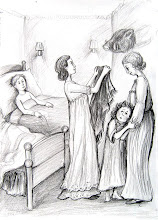" 'The Deceptiveness of Beauty' Mother Love and Mother Hate in To the Lighthouse." Twentieth Century Literature 23.3 (1977): 345-377
Lilienfield suggests that To the Lighthouse was Virginia Woolf’s way of creating an escape to the anger and hurt that she felt as a result of the poor relationship between her and her mother. Lilienfield argues that by Woolf creating the type of character found in Lily, an orphaned child who longs to be a part of Mrs. Ramsay but is cut off, she has created an autobiographic image of herself. The empty space that Lily leaves in her painting is an objective representation of a state of mourning for the “archetypal mother essence” (347) that both she and Woolf desired. Lilienfield then goes on to say that there is a link that ties in the process that Lily goes through in her painting and Woolf’s writing. The emptiness left in the canvas that Lily is working on, from the beginning of the book until she finishes in the end, is the same pattern followed by Woolf when writing the novel. Woolf wrote the novel in her 40’s and Lily finishes her painting at age 44. The thoughts that flow through Lily’s mind are incomplete until she draws the line in the middle; in the same manner, Lilienfield states that “on the last page of the typerscript, Virginia Woolf has divided the page into thirds, just as Lily Briscoe’s picture is divided. Down the center of the page, just as down the center of the painting, Lily Briscoe/Virginia Woolf has drawn one central line” (373).
This journal article allowed me to see the connection between the painting pattern followed by Lily Briscoe in To the Lighthouse as well as Virginia Woolf’s writing pattern. By being informed of how it is that Woolf crafted her novel, the reader can experience a more intimate moment with the work. If Woolf is indeed in a state of mourning for the mother essence, then the reflection of her state of mind is shown through Lily with vivid imagery. Lily’s inability to grasp her own identity and separate it from that of whom Mrs. Ramsay and society expect a woman to be turns into something that Lily must defeat, which was the case for Woolf and the expectations many had for her. Despite the fact that Woolf was expected to be a typical woman, she chose to be true to herself and her work, which is also reflected in Lily’s decision to not marry, at least until she is done with her painting. There is an empowering reaction from the part of the reader that allows Woolf to penetrate even the most doubtful and deepest desires of the heart. Through Lily’s conscious desire to reflect and find the missing piece of her painting I can sense that Woolf was also searching for her life to have a sense of closure. I can sympathize more with Woolf as a writer and with Lily as a painter when I know that they are one and that the pain reflected in the creators creation is true; it gives me the opportunity to believe that there is more to the story then just words.
Subscribe to:
Post Comments (Atom)



No comments:
Post a Comment